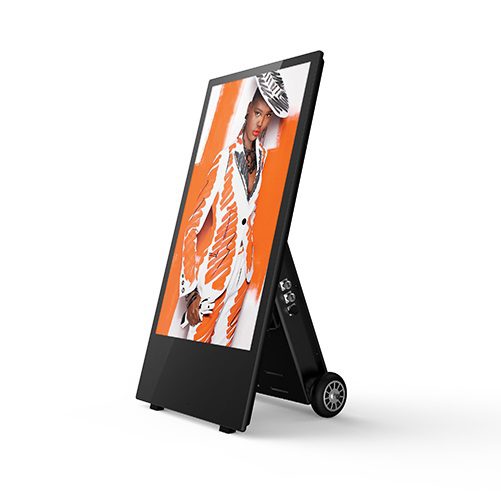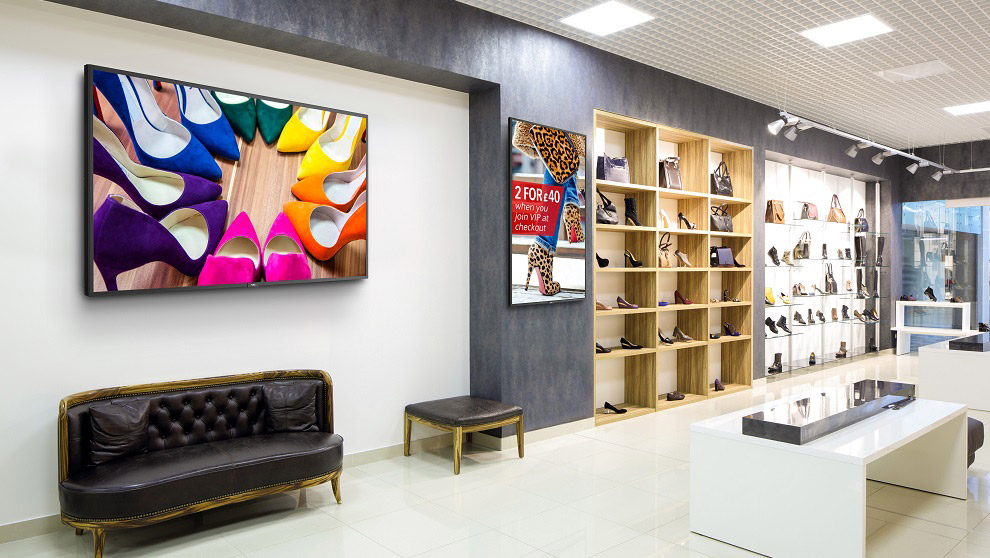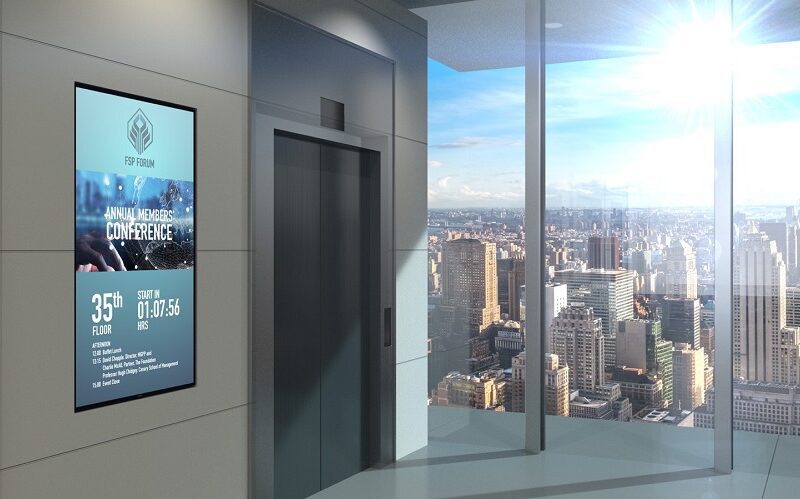The Top 10 Benefits of Digital Signage in Retail for 2026

In the fast-moving world of consumer goods, there are some long-lasting benefits of digital signage in retail environments that help to make the business case for investing in this innovative technology.
From displaying products at their best, to agilely updating prices and promotions, to enabling customers to provide you with direct feedback, the uses for digital signage in retail go on and on.
This guide shortlists the top 10 benefits of digital signage in shops, so you can make sure that you are getting the maximum positive impact on your business when using digital displays.
Transform your retail environment
One of the biggest benefits of digital signage in retail environments is the transformational effect the technology can have, bringing vibrant and persuasive graphics into spaces that previously relied on traditional print point of sale (POS) materials to increase sales.
1. Make messages more eye-catching
Digital screens are bright, colourful and animated, grabbing shoppers’ attention so there is less chance that they will miss your marketing message. Your screens can highlight promotions, advertise your most profitable products, and drive footfall to parts of your store that are usually less visited.
2. Improve consistency between different sites
One of the top benefits of digital signage in retail premises across chains and franchises is the ability to create a consistent visual aesthetic. By adding digital signage screens and showing the same high quality content across locations, you let customers know that they are all part of the same parent brand.
3. Keep your retail spaces feeling fresh
Another of the main uses for digital signage in retail premises is to ensure your marketing is updated with fresh new images on a regular basis. This has a natural knock-on effect by helping your physical premises to seem more upkept and prevent them from seeming tired-looking to shoppers.
Maximise the impact of your branding
We touched on franchise branding as one of the big benefits of digital signage in shops, but it goes beyond just creating a consistent visual aesthetic. Retail digital signage gives you a dynamic voice for all kinds of brand awareness campaigns.
4. Central control of marketing messages
Because digital signage can be managed centrally with user permissions controlled via the CMS (content management system), the franchiser can retain control of the content displayed. Screens can be scheduled to display information of interest to staff prior to each store’s opening time, before changing to customer-oriented content once the store is open.
5. Immersive brand experiences
Greater immersivity is another of the most compelling benefits of digital signage in retail environments. Motion sensors can be used to display information dynamically when a customer walks past, looks at or lifts up an item.
Cameras built into interactive screens can also enable virtual try-ons, creating a ‘magic mirror’ for customers to see what an item of clothing or a makeup product will look like on them, without needing to visit a fitting room.
Deliver your campaigns more effectively
Effective delivery of campaign materials is one of the big benefits of digital signage in retail chains, but also in individual stores as an agile and flexible way to run time-limited promotions across different departments.
6. Instant marketing campaign delivery
With a CMS like our own SaturnVision, you can introduce and withdraw campaigns at the touch of a button across all the screens in one or more outlets. This can also be automated by scheduling the campaign for a certain start and finish time. Images are automatically resized to display correctly on different sizes of screen – you can learn more about this in our Ultimate Guide to Digital Signage Content Creation.
For even more flexible implementation of campaigns, invest in mobile totems or portable digital A-boards, which can run on battery power where a plug socket is not available. The imagery is controlled from your usual CMS and can display promotional messages, event-specific images (e.g. for a pop-up tasting event) or temporary health and safety warnings.
7. Increase total promotional space
Digital signage can cycle through as many marketing messages as you wish, which can be scheduled for different times of day. This vastly increases the capacity and relevance of your promotional signage space, compared with static print posters. You can even sell advertising space to third parties as a way to generate additional revenue.
8. Tailor messages by time and location
The scheduling option is one of the major benefits of digital signage in retail settings, as it empowers you to dynamically vary your advertising according to the location and time of day, all from your central CMS dashboard. Seasonal campaigns can be implemented quickly and easily with very little cost. Stores across a chain can be placed into groups (e.g. different pricing tiers) and relevant information transmitted to their screens accordingly.
This extends to other uses for digital signage in retail premises, such as dynamic shelf-edge displays which can be updated remotely, so that staff do not have to manually adjust pricing during promotional periods, or when you update your prices across the store.
Increase your operational efficiency
Improving efficiency is arguably one of the most important benefits of digital signage in shops, as a way to streamline operations and capitalise on customer feedback.
9. Instant customer feedback
Touchscreen digital signage allows customers to provide feedback that you can access instantly from your CMS. This can include satisfaction surveys, feedback on customer service, and whether the customer found everything they were looking for. This gives you real-time useful data you can use to identify and tackle any problem points more quickly.
10. Improve wayfinding in large stores
Giving customers wayfinding information can help to keep them happy and, crucially, get them to the parts of your store where they are most likely to spend more money. Digital signage screens are great for this, and can also display other useful information such as store opening and closing times, and any important health and safety warnings.
You can tell shoppers it’s time to head to the checkout, as the store is about to close, or help customers navigate to your best promotions and new product lines. Whatever you want to communicate, you have the signs you need to do so.
Reaping the benefits of retail digital signage
Digital signage for retail environments has so much potential and has grown rapidly in popularity in recent years as more retailers embrace the kinds of benefits listed above.
Adopting digital signage encourages innovation and a creative approach to revenue generation. You can test different ideas and images, using pilot schemes to see what works with your customer base. Success can be replicated to other departments and stores at the touch of a button.
Get the digital signage content you need
Working with a professional digital signage consultant is a good way to start. They will work with you to set out some business aims and campaign goals, as well as assessing the physical space in your retail premises.
From there, they will identify the types of screens, enclosures and content that should be most effective in achieving your goals, while addressing any challenges your business faces on a day-to-day basis.
Your content should be more than just wallpaper. Well-designed content should be easily visible on different screen sizes – or should be targeted at screens of the appropriate size and aspect ratio. Imagery should be eye-catching, not lacklustre, making good use of the vibrant and dynamic display technology.
Speak to an expert
Success with digital signage comes from careful consideration of content and the types of screens on which it is displayed. That’s why our digital signage consultants work with you to ensure that your content is tailored to achieve your business goals.
Don’t just install a screen and put some marketing messages on it. Optimise your branding, advertising and promotional messaging. We don’t work with 3rd parties for advertising space and it is a lot more difficult to do than you’d think. Let’s not push that message. Implement campaigns in an agile and informed way.
Work with your long-term goals in mind, and you’ll be amazed by the results digital signage can deliver for your retail business.
Find out more about digital signage in retail environments
If you’d like to know more about the uses of digital signage in retail, take a look at some of our case studies:
If this is your first digital signage project, why not check out some of our articles on getting it right first time?
Finding a good digital signage service provider
Getting a good digital signage ROI
The top 20 most common digital signage mistakes businesses make
If you have a retail digital signage project in mind, speak to our team and get some advice and a competitive quote today. Call us on 0161 222 0706 or use the form below.
Ready to make an impact?
Get in touch now for competitive prices, good advice, & slick project delivery







